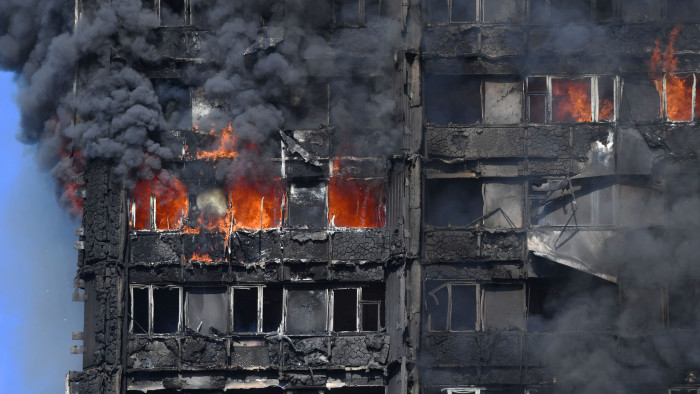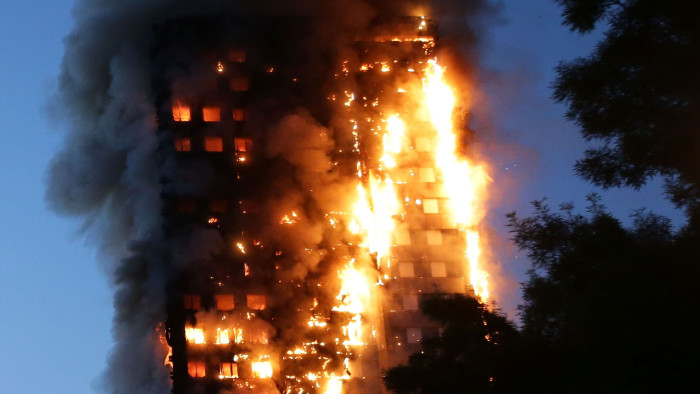Grenfell blaze inquiry report explained

Roula Khalaf, Editor of the FT, selects her favourite stories in this weekly newsletter.
After two years of hearing testimony and examining thousands of documents, the report into the first phase of the inquiry into the June 2017 fire at the 24-storey Grenfell Tower in London that killed 72 people has been published.
What are the key findings?
The report focuses on the night of the fire.
The fire brigade’s preparations for a disaster like the Grenfell fire had been “gravely inadequate”, leading to failures in communications and management. If the tower had been evacuated earlier, “more lives could have been saved”.
Failures in the response echoed those during a fire at Lakanal House in Southwark in 2009, which killed six people, despite reviews which followed that blaze.
Call handlers were overwhelmed by the volume of emergency calls that came in from the tower, and thus gave out wrong information and failed to get the right information from callers.
Evidence by Dany Cotton, the London fire commissioner, to the inquiry that she would not change anything about the brigade’s actions on the night “demonstrate that the [fire brigade] is an institution at risk of not learning the lessons of the Grenfell disaster”.
The materials used to reclad the exterior of the Grenfell Tower in 2016 caused the fire to spread with lethal speed and were in breach of building regulations. Malfunctioning fire doors enabled smoke and toxic fumes to spread.
Grenfell resident Behailu Kebede, in whose fridge-freezer the fire began, responded swiftly, including by calling emergency services, and “bears no blame” for the disaster.
What are the recommendations?
The government should urgently speed up its programme of replacing dangerous cladding on other buildings and legislate to require high-rise residential building managers and owners to develop evacuation plans.
The new law should also require building managers and owners to inspect fire doors; to provide building information to fire services; to place floor plan and lift information in an information box in each building; and to carry out regular lift inspections.
Fire and rescue services, and the government, should develop national guidelines for building evacuations.
Fire brigades should ensure that all staff are trained in the risks of façade fires.
Communications systems used by London’s fire brigade, ambulance service and police should be compatible with each other.

What happens next?
Boris Johnson, the prime minister, accepted the report’s findings “in principle” and added that the government would legislate to implement the recommendations. But no timetable has been set out, as ministers prepare for an election in December and a planned Brexit date at the end of January.
Martin Moore-Bick, the inquiry chair, will proceed to the second phase of his inquiry next year. That will look at the broader factors leading up to the blaze, including the refurbishment of the building.
“The principal focus of phase two will be on the decisions which led to the installation of a highly combustible cladding system on a high-rise residential building and the wider background against which they were taken,” Sir Martin said.
It will also look at how the fire brigade is managed and why authorities ignored warnings from residents on fire safety before the disaster.
The Metropolitan Police will continue its investigation but has said that no criminal charges will be brought until after Sir Martin’s final report, which could come as late as 2022. Inquests into the deaths of the 72 victims have also been adjourned.
Ms Cotton plans to retire next year but faced renewed calls for her resignation on Wednesday.
Are any companies affected?
The report mentioned the US group Arconic, which manufactured the cladding panels on the Grenfell tower; Celotex, a division of the French multinational Saint Gobain, which made insulation used on the tower; Rydon, the design and build contractor on the refurbishment; Harley Facade, to which Rydon subcontracted the cladding installation; and CEP Architectural Facades, which manufactured the cladding into “cassettes” for use on the tower.
The report does not assign blame to any individual companies, or assess the role of the local council or tenant management organisation which ran the building.
Hotpoint, a division of Whirlpool, made the fridge-freezer in which the fire began, but Sir Martin said he considered the fault in the device “to be of less importance than establishing how the failure of a common domestic appliance could have had such disastrous consequences”.
How are survivors responding?
Grenfell United, the largest group representing survivors and victims’ families, said the report gives “us some confidence that our journey towards truth has finally begun”.
It called for immediate action on the recommendations in the report, along with “criminal charges . . . against those responsible for turning our homes into a ‘death trap’.”
Comments